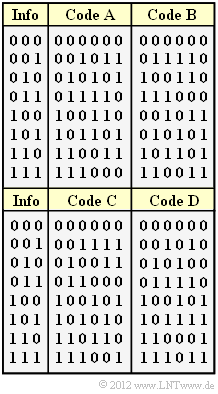Exercise 1.08Z: Equivalent Codes
From LNTwww
In the graph, the mappings $\underline{u} \rightarrow \underline{x}$ for different codes are given, each characterized below by the generator matrix $\boldsymbol{\rm G}$ and the parity-check matrix $\boldsymbol{\rm H}$ respectively:
- ${\boldsymbol{\rm Code \ A}}$:
- $${ \boldsymbol{\rm G}}_{\rm A} = \begin{pmatrix} 1 &0 &0 &1 &1 &0\\ 0 &1 &0 &1 &0 &1\\ 0 &0 &1 &0 &1 &1 \end{pmatrix} \hspace{0.05cm},\hspace{0.5cm}{ \boldsymbol{\rm H}}_{\rm A} = \begin{pmatrix} 1 &1 &0 &1 &0 &0\\ 1 &0 &1 &0 &1 &0\\ 0 &1 &1 &0 &0 &1 \end{pmatrix} \hspace{0.05cm}.$$
- ${\boldsymbol{\rm Code \ B}}$:
- $${ \boldsymbol{\rm G}}_{\rm B} = \begin{pmatrix} 0 &0 &1 &0 &1 &1\\ 1 &0 &0 &1 &1 &0\\ 0 &1 &1 &1 &1 &0 \end{pmatrix} \hspace{0.05cm},\hspace{0.5cm} { \boldsymbol{\rm H}}_{\rm B} = \begin{pmatrix} 1 &0 &1 &0 &1 &0\\ 1 &1 &0 &1 &0 &0\\ 0 &1 &1 &0 &0 &1 \end{pmatrix} \hspace{0.05cm}.$$
- ${\boldsymbol{\rm Code \ C}}$:
- $${ \boldsymbol{\rm G}}_{\rm C} = \begin{pmatrix} 1 &0 &0 &1 &0 &1\\ 0 &1 &0 &0 &1 &1\\ 0 &0 &1 &1 &1 &1 \end{pmatrix} \hspace{0.05cm},\hspace{0.5cm}{ \boldsymbol{\rm H}}_{\rm C} = \begin{pmatrix} 1 &0 &1 &1 &0 &0\\ 0 &1 &1 &0 &1 &0\\ 1 &1 &1 &0 &0 &1 \end{pmatrix} \hspace{0.05cm},$$
- ${\boldsymbol{\rm Code \ D}}$:
- $${ \boldsymbol{\rm G}}_{\rm D} = \begin{pmatrix} 1 &0 &0 &1 &0 &1\\ 0 &1 &0 &1 &0 &0\\ 0 &0 &1 &0 &1 &0 \end{pmatrix} \hspace{0.05cm},\hspace{0.5cm}{ \boldsymbol{\rm H}}_{\rm D} = \begin{pmatrix} 1 &1 &0 &1 &0 &0\\ 0 &0 &1 &0 &1 &0\\ 1 &0 &0 &0 &0 &1 \end{pmatrix} \hspace{0.05cm}.$$
This task is to investigate which of these codes or code pairs are
- are systematic,
- are identical (that is: Different codes have same code words),
- are equivalent (that is: Different codes have same code parameters).
Hints :
- This exercise belongs to the chapter General Description of Linear Block Codes.
- Reference is made in particular to the pages Systematic Codes and Identical Codes.
- Note that the specification of a parity-check matrix $\boldsymbol{\rm H}$ is not unique.
- If one changes the order of the parity-check equations, this corresponds to a swapping of rows.
Questions
Musterlösung
(1) Richtig sind die Antworten 1, 3 und 4:
- Für einen systematischen (6, 3)–Blockcode muss gelten:
- $$\underline{x} = ( x_1, x_2, x_3, x_4, x_5, x_6) = ( u_1, u_2, u_3, p_1, p_2, p_{3}) \hspace{0.05cm}.$$
Diese Bedingung erfüllen Code A, Code C und Code D, nicht aber Code B.
(2) Richtig ist nur Antwort 1:
- Nur Code A und Code B sind identische Codes. Sie beinhalten genau die gleichen Codeworte und unterscheiden sich nur durch andere Zuordnungen $\underline{u} \rightarrow \underline{x}$.
- Wie in der Musterlösung zur Aufgabe A1.8 (3) angegeben, gelangt man von der Generatormatrix ${ \boldsymbol{\rm G}}_{\rm B}$ zur Generatormatrix ${ \boldsymbol{\rm G}}_{\rm A}$
- allein durch Vertauschen/Permutieren von Zeilen, oder
- durch Ersetzen einer Zeile durch die Linearkombination zwischen dieser Zeile und einer anderen.
(3) Richtig ist somit allein Antwort 2:
- Code A und Code B sind mehr als äquivalent, nämlich identisch.
- Code C und D unterscheiden sich zum Beispiel auch durch die minimale Hamming–Distanz $d_{\rm min} = 3$ bzw. $d_{\rm min} = 2$ und sind somit auch nicht äquivalent.
- Code B und Code C zeigen dagegen gleiche Eigenschaften, beispielsweise gilt für beide $d_{\rm min} = 3$. Sie beinhalten aber andere Codeworte.
(4) Richtig ist Antwort 3:
- Die letzte Spalte von ${ \boldsymbol{\rm G}}_{\rm B}$ ergibt die erste Spalte von ${ \boldsymbol{\rm G}}_{\rm C}$.
- Die erste Spalte von ${ \boldsymbol{\rm G}}_{\rm B}$ ergibt die zweite Spalte von ${ \boldsymbol{\rm G}}_{\rm C}$.
- Die zweite Spalte von ${ \boldsymbol{\rm G}}_{\rm B}$ ergibt die dritte Spalte von ${ \boldsymbol{\rm G}}_{\rm C}$, usw.
(5) Alle Aussagen treffen zu:
- Die Bedingung ${ \boldsymbol{\rm H}} \cdot { \boldsymbol{\rm G}}^{\rm T} = \boldsymbol{0}$ gilt für alle linearen Codes.
